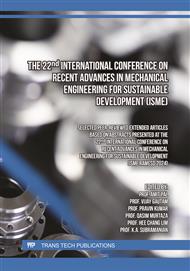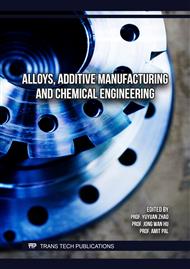[1]
Mingming Wu, Thomas Cubaud, and Chih-Ming Ho. Scaling law in liquid drop coalescence driven by surface tension. Physics of Fluids, 16(7):L51-L54, 2004.
DOI: 10.1063/1.1756928
Google Scholar
[2]
Rabea Seyboldt and Frank Jülicher. Role of hydrodynamic flows in chemically driven droplet division. New journal of physics, 20(10):105010, 2018.
DOI: 10.1088/1367-2630/aae735
Google Scholar
[3]
Jens Eggers, John R Lister, and Howard A Stone. Coalescence of liquid drops. Journal of Fluid Mechanics, 401:293-310, 1999.
DOI: 10.1017/s002211209900662x
Google Scholar
[4]
Yan Zhang, Shenglin Yan, and Zhishan Bai. Effect of salt addition on the coalescence process of droplets on fiber. Chemical Engineering Science, 274:118628, 2023.
DOI: 10.1016/j.ces.2023.118628
Google Scholar
[5]
Robert W Hopper. Plane stokes flow driven by capillarity on a free surface. Journal of Fluid Mechanics, 213:349-375, 1990.
DOI: 10.1017/s002211209000235x
Google Scholar
[6]
Robert W Hopper. Stokes flow of a cylinder and half-space driven by capillarity. Journal of fluid mechanics, 243:171-181, 1992.
DOI: 10.1017/s0022112092002684
Google Scholar
[7]
Robert W Hopper. Coalescence of two viscous cylinders by capillarity: Part 1, theory. Journal of the american ceramic society, 76(12):2947-2952, 1993.
DOI: 10.1111/j.1151-2916.1993.tb06594.x
Google Scholar
[8]
Prashant Narayan Panday, Aditya Bandopadhyay, and Prasanta Kumar Das. Surfing of particles and droplets on the free surface of a liquid: a review. The European Physical Journal Special Topics, 232(6):735-768, 2023.
DOI: 10.1140/epjs/s11734-022-00726-z
Google Scholar
[9]
Daniel Rosenfeld. Suppression of rain and snow by urban and industrial air pollution. science, 287(5459):1793-1796, 2000.
DOI: 10.1126/science.287.5459.1793
Google Scholar
[10]
Lord Rayleigh. The influence of electricity on colliding water drops. Proceedings of the royal society of London, 28:405-409, 1878.
Google Scholar
[11]
Stephen P Reynolds. Continuum spectra of collimated, ionized stellar winds. The Astrophysical Journal, 304:713-720, 1986.
DOI: 10.1086/164209
Google Scholar
[12]
Joseph John Thomson and Hugh Frank Newall. V. on the formation of vortex rings by drops falling into liquids, and some allied phenomena. Proceedings of the royal society of London, 39(239-241):417-436, 1886.
DOI: 10.1098/rspl.1885.0034
Google Scholar
[13]
Hasan N Oguz and Andrea Prosperetti. Surface-tension effects in the contact of liquid surfaces. Journal of Fluid Mechanics, 203:149-171, 1989.
DOI: 10.1017/s0022112089001412
Google Scholar
[14]
A Menchaca-Rocha, ANRS Martínez-Dávalos, R Nunez, S Popinet, and S Zaleski. Coalescence of liquid drops by surface tension. Physical Review E, 63(4):046309, 2001.
DOI: 10.1103/physreve.63.046309
Google Scholar
[15]
L Duchemin, Jens Eggers, and C Josserand. Inviscid coalescence of drops. Journal of Fluid Mechanics, 487:167-178, 2003.
DOI: 10.1017/s0022112003004646
Google Scholar
[16]
KD Willis and ME Orme. Experiments on the dynamics of droplet collisions in a vacuum. Experiments in Fluids, 29(4):347-358, 2000.
DOI: 10.1007/s003489900092
Google Scholar
[17]
Keeney Willis and Melissa Orme. Binary droplet collisions in a vacuum environment: an experimental investigation of the role of viscosity. Experiments in fluids, 34(1):28-41, 2003.[18] Dirk GAL Aarts, Henk NW Lekkerkerker, Hua Guo, Gerard H Wegdam, and Daniel Bonn. Hydrodynamics of droplet coalescence. Physical review letters, 95(16):164503, 2005.
DOI: 10.1007/s00348-002-0526-4
Google Scholar
[19]
W Yao, HJ Maris, P Pennington, and GM Seidel. Coalescence of viscous liquid drops. Physical Review E, 71(1):016309, 2005.
DOI: 10.1103/physreve.71.016309
Google Scholar
[20]
Joseph D Paulsen, Rémi Carmigniani, Anerudh Kannan, Justin C Burton, and Sidney R Nagel. Coalescence of bubbles and drops in an outer fluid. Nature communications, 5(1):1-7, 2014.
DOI: 10.1038/ncomms4182
Google Scholar
[21]
Kamel Fezzaa and Yujie Wang. Ultrafast x-ray phase-contrast imaging of the initial coalescence phase of two water droplets. Physical review letters, 100(10):104501, 2008.
DOI: 10.1103/physrevlett.100.104501
Google Scholar
[22]
Keunho Ahn, Jeremy Agresti, Henry Chong, Manuel Marquez, and David A Weitz. Electrocoalescence of drops synchronized by size-dependent flow in microfluidic channels. Applied Physics Letters, 88(26):264105, 2006.
DOI: 10.1063/1.2218058
Google Scholar
[23]
JC Burton and P Taborek. Role of dimensionality and axisymmetry in fluid pinch-off and coalescence. Physical review letters, 98(22):224502, 2007.
DOI: 10.1103/physrevlett.98.224502
Google Scholar
[24]
Jing Jin, Chin Hong Ooi, Dzung Viet Dao, and Nam-Trung Nguyen. Coalescence processes of droplets and liquid marbles. Micromachines, 8(11):336, 2017.
DOI: 10.3390/mi8110336
Google Scholar
[25]
Prashant Narayan Panday, Shreyansh Darshan, Aditya Bandopadhyay, and Prasanta Kumar Das. Merging of two droplets at an air-water interface driven by surface tension gradient. Chemical Engineering Science, page 119769, 2024.
DOI: 10.1016/j.ces.2024.119769
Google Scholar
[26]
Yves Couder, E Fort, C-H Gautier, and A Boudaoud. From bouncing to floating: noncoalescence of drops on a fluid bath. Physical review letters, 94(17):177801, 2005.
DOI: 10.1103/physrevlett.94.177801
Google Scholar
[27]
Y Couder, A Boudaoud, S Protière, and E Fort. Walking droplets, a form of wave-particle duality at macroscopic scale? Europhysics News, 41(1):14-18, 2010.
DOI: 10.1051/epn/2010101
Google Scholar
[28]
Boris Filoux, Maxime Hubert, and Nicolas Vandewalle. Strings of droplets propelled by coherent waves. Physical Review E, 92(4):041004, 2015.
DOI: 10.1103/physreve.92.041004
Google Scholar
[29]
Boris Filoux, Maxime Hubert, Peter Schlagheck, and Nicolas Vandewalle. Walking droplets in linear channels. Physical Review Fluids, 2(1):013601, 2017.
DOI: 10.1103/physrevfluids.2.013601
Google Scholar



